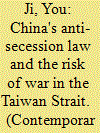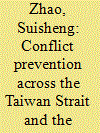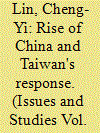| Srl | Item |
| 1 |
ID:
072887


|
|
|
|
|
| Publication |
2006.
|
| Summary/Abstract |
The product of a ten-year debate, China's Anti-Secession Law assures Taiwan and the world that peaceful independence is a myth. The law explains that China is building military superiority to prevent Taiwan's de jure independence. This threat is matched by peace inducements, mainly economic integration, to increase the cost of independence. The ASL channels hard and soft approaches into one legal framework. Yet to this author, the ASL is fundamentally not a piece of law but a statement of Hu Jintao's new thinking. It enriches China's Taiwan policy of maintaining peace through the threat of war, the final line of defence against de jure Taiwanese independence. This article explains how the status quo is used against independence and how deliberate ambiguity has enlarged Beijing's space of manoeuvring with both Taipei and Washington. Beijing does not want war, but it must insist on its likelihood. The absence of a reunification timetable in the ASL shows that Beijing is not in a hurry to resolve the Taiwan issue. Beijing also has encouraged Washington to play a more active role in coordinating the cross-Strait interaction. The likelihood of war can best be reduced by building ambiguity into the cross-Strait relationship to avoid pressure for drastic action.
|
|
|
|
|
|
|
|
|
|
|
|
|
|
|
|
| 2 |
ID:
070705


|
|
|
|
|
| Publication |
2006.
|
| Summary/Abstract |
China has developed a unique approach of conflict prevention characterized by liangshou celue -- literally, a "two hands" or a two-pronged strategy. It is a stick-and-carrot approach, involving an oscillating pattern of military coercion and peaceful offensive. After the fourth generation of Chinese leadership under Hu Jintao came to office, an Anti-Secession Law was passed by China's National People's Congress on March 14, 2005. Prescribing the conditions for military action against Taiwan, this law was described by some people in the West and Taiwan as a war authorization law, mainly driven by Chinese nationalism, to set a benchmark against nationalist pressure and show Chinese leaders' willingness to risk war across the Taiwan Strait at all cost. It thus is said to signify not only greater irrationality in China's policy toward Taiwan but also a change in the two-pronged conflict-prevention approach. Is Chinese nationalism in fact a cause of international aggression, making China's policy toward Taiwan irrational and inflexible? Does the Anti-Secession Law signal that Beijing is on a path that reduces its scope for rational choices? This article will explore the making of the Anti-Secession Law to find answers to these questions.
|
|
|
|
|
|
|
|
|
|
|
|
|
|
|
|
| 3 |
ID:
066391


|
|
|
| 4 |
ID:
077037


|
|
|